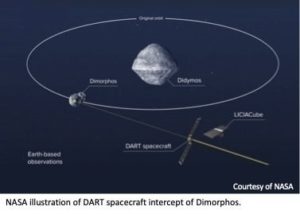The National Aeronautics and Space Administration (NASA) press office announced the launch of the “world’s first full-scale mission” to demonstrate and assess NASA’s ability to keep Earth safe from a collision with a comet, asteroid, or similar cosmic hazard. Resting atop a SpaceX Falcon 9 rocket, the Double Asteroid Redirection Test (DART) spacecraft blasted off from Space Launch Complex 4 East at Vandenberg Space Force Base in California at 1:24 a.m. EST, November 24.
 The combined commercial SpaceX, NASA, and US Space Force DART mission is to track, target, and impact an asteroid in space to determine if that impact could alter the object’s trajectory to knock it off a hypothetical collision course with Earth. This method of countering a potentially hazardous asteroid is called “kinetic impactor technique.” That means DART will hit the target. In this case, that target is an asteroid named Dimorphos. In a BBC News description of the DART mission, Paul Rincon writes:
The combined commercial SpaceX, NASA, and US Space Force DART mission is to track, target, and impact an asteroid in space to determine if that impact could alter the object’s trajectory to knock it off a hypothetical collision course with Earth. This method of countering a potentially hazardous asteroid is called “kinetic impactor technique.” That means DART will hit the target. In this case, that target is an asteroid named Dimorphos. In a BBC News description of the DART mission, Paul Rincon writes:
“The $325m mission targets a pair of asteroids that closely orbit each other — known as a binary. The larger of the two objects, called Didymos, measures around 780m (853 yds) across, while its smaller companion Dimorphos – is around 160m (175 yds) wide…After escaping Earth’s gravity, DART will follow its own orbit around the Sun. It will then intercept the binary as it approaches within 6.7 million miles of Earth in September 2022.”
DART will crash into Dimorphos at a speed of close to 15,000mph. At that speed, the energy of the collision is estimated to change the velocity of Dimorphos a tiny portion of a millimeter per second, enough to alter its orbit around Didymos. “It’s a very small shift, but it could be just enough to knock an object off a collision course with Earth. “This isn’t going to destroy the asteroid,” said mission official Nancy Chabot of Johns Hopkins Applied Physics Laboratory, which is managing the project. “It’s just going to give it a small nudge.”
So, if you are cowering in your basement after viewing for the fourth or fifth time the movies “Armageddon,” or “Meteor,” or “Deep Impact,” or even “Space Cowboys” and paralyzed with fear of a cataclysmic collision between Earth and a massive extraterrestrial boulder, fear no longer. You can breathe a sigh of relief. NASA is on the job and confident that its DART demonstration will be successful.

Nonetheless, those concerned about Earth-comet-asteroid collisions are no chicken littles. Such impacts have happened before. The Planetary and Space Science Center at the University of New Brunswick Fredericton in Canada keeps the Earth Impact Database listing 190 confirmed impact craters around the globe.
Space.com explains the oldest of these craters, the Yarrabubba Crater in Western Australia, is 2.23 billion years old (give or take five million years, we’re told) and measures 43 miles across. According to David Bressan writing for Forbes, the most recent, the Yilan meteorite crater, is between 47,000 and 53,000 years old and located in Siberia. It’s safe to say that such collisions are infrequent but possible.
Consequently, it’s that possibility – and a reasonable sense of precaution – that led NASA to establish the Planetary Defense Coordination Office (PDCO) in January 2016. The focus of the PDCO is to monitor and track Near-Earth Objects, or NEOs. The NEOs are asteroids and comets that orbit the Sun like the planets, but their orbits can bring them into Earth’s neighborhood — within 30 million miles of Earth’s orbit. PDCO’s mission is four-fold: find, warn, mitigate, and coordinate.
- Detect potentially hazardous objects (PHOs) with a size large enough to damage the surface of the Earth (33 yds to 55 yds) whose orbits are predicted to approach within five million miles of Earth’s orbit around the Sun.
- Track and describe the PHOs and issue warnings of possible impacts and the effects.
- Develop strategies and technologies to thwart PHO impacts.
- Play a pivotal role in coordinating U.S. government planning and responses to an actual impact.
Underpinning national security – in fact, global security – NASA’s role and leadership is crucial. The establishment of the U.S. Space Force by the Trump administration, though not without early detractors, with its space launch facilities and space tracking capability is a critical element in defending the homeland from ultra-high-speed space rocks slamming into the Earth.
The views expressed are those of the author and not of any other affiliation.
~ Read more from Dave Patterson.




